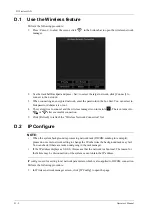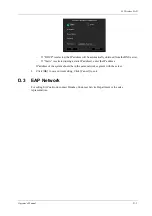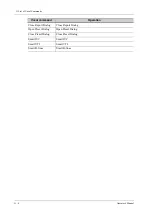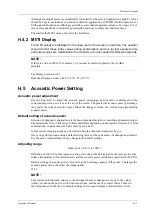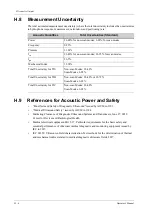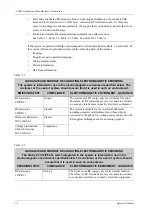
H - 4
Operator’s Manual
H Acoustic Output
Following the ALARA restriction, you are allowed to increase the acoustic power under FDA
510 (k) Guidance-Track 3 limits and to set it in the image preset screen.
The acoustic output of the system has been measured and calculated in accordance with IEC60601-
2-37: 2015, FDA 510(K) GUIDANCE, IEC 62359: 2017, Ultrasonics-Field characterization-Test
methods for the deter mination of thermal and mechanical indices related to medical diagnostic
ultrasonic fields.
H.6
Acoustic Power Control
The qualified operator may use the system controls to limit the ultrasound output and to adjust the
quality of the images. There are three categories of system controls relative to output. They are,
•
Controls that have direct effect on the output
•
Controls that indirectly control output
•
Controls that are receiver controls
Direct controls
It is possible to control, if necessary, the acoustic output with the “A.power” item. In this case, the
maximum value of the acoustic output never exceeds an MI of 1.9 and an I
SPTA.3
of 720 mW/cm
2
in any mode of operation.
Indirect controls
The controls that indirectly affect output are the many imaging parameters. These are operating
modes, frequency, focal point positions, overall depth, and PRF.
The operating mode determines whether the ultrasound beam is scanning or non-scanning. Thermal
bioeffect is closely connected to M mode, Doppler and Color mode. Acoustic attenuation of tissue
is directly related to probe frequency. The focal point is related to active aperture of probe and beam
width. For the higher PRF (pulse repetition frequency), the more output pulses occur over a period
of time.
Receiver controls
The receiver controls (for example, gain, dynamic range, and image post-processing, etc.) won’t
affect output. These controls should be used, when possible, to improve the image quality before
using controls that directly or indirectly affect output.
H.7
Acoustic Output
H.7.1 Derated Ultrasonic Output Parameters
In order to determine the relevant Ultrasonic Output Parameters, a method is used which allows for
the comparison of ultrasound systems which operate at different frequencies and are focused at
different depths. This approach, called “derating” or “attenuating”, adjusts the acoustic output as
measured in a water tank to account for the effect of ultrasound propagation through tissue. By
convention, a specific average intensity attenuation value is used, which corresponds to a loss of 0.3
dB/cm/MHz. That is, the intensity of ultrasound will be reduced by 0.3 dB/MHz for every
centimeter of travel from the probe. This can be expressed by the following equation:
Iatten
Iwater 10
0.3
–
(
)
10
⁄
fc z
×
×
(
)
×
=
Содержание Ana
Страница 2: ......
Страница 50: ...This page intentionally left blank...
Страница 60: ...This page intentionally left blank...
Страница 110: ...This page intentionally left blank...
Страница 116: ...This page intentionally left blank...
Страница 166: ...This page intentionally left blank...
Страница 176: ...This page intentionally left blank...
Страница 194: ...This page intentionally left blank...
Страница 220: ...This page intentionally left blank...
Страница 288: ...This page intentionally left blank...
Страница 304: ...This page intentionally left blank...
Страница 308: ...This page intentionally left blank...
Страница 316: ...This page intentionally left blank...
Страница 337: ......
Страница 338: ...P N 046 018835 00 2 0...

